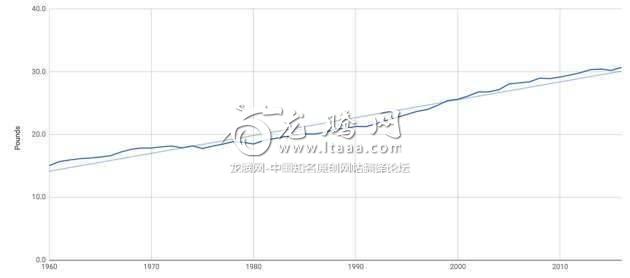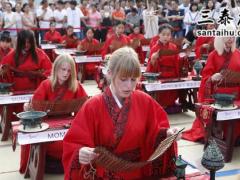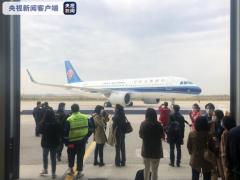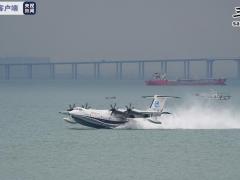大西洋月刊:现在的火鸡是1960年时的两倍大 [美国媒体]
今天的火鸡已经不是昔日的火鸡。几十年来,动物饲养者一直在改变火鸡的基因组,让它们变得越来越大。自1960年以来,火鸡的重量每年增加约四分之一磅,从而使这种鸟类的平均体重从1960年的15.1磅增加到2017年的31.1磅。
For decades, poultry breeders have transformed the genomes of turkeys, creating ever-larger birds.
几十年来,家禽饲养者已经改变了火鸡的基因组,创造了越来越大的鸟类。
A turkey today is not the turkey of yesteryear.
今天的火鸡已经不是昔日的火鸡。
For decades, animal breeders have been transforming the genomes of turkeys to make them grow larger. Since 1960, the weight of turkeys has gone up about a quarter of a pound each year. The average weight of a turkey has gone from 15.1 pounds in 1960 to 31.1 pounds in 2017.
几十年来,动物饲养者一直在改变火鸡的基因组,让它们变得越来越大。自1960年以来,火鸡的重量每年增加约四分之一磅,从而使这种鸟类的平均体重从1960年的15.1磅增加到2017年的31.1磅。
Average Turkey Weight 1960-2016
1960年至2016年期间土鸡的平均体重
And most of that change has been genetic. In one study of a representative strain of turkeys, poultry researchers fed the same diet to turkeys from 2003 and to a control group of turkeys that were representative of that strain’s genetic pool from 1966. On average, the 2003 females grew to 33 pounds. Their 1966 cousins only got to 16.3 pounds.
大部分的变化都是具有遗传性的。在一项对火鸡的一种有代表性的类别的研究中,家禽研究人员从2003年开始给一组普通火鸡和一组取自1966年的这一种类基因库中具有代表性的受控火鸡群体提供相同的饮食。平均而言,2003年的雌性火鸡体重增加到了33磅,它们1966年的表亲只有16.3磅。
The 2003 turkeys also grew much faster, reaching the same saleable weight twice as fast as their 1966 cousins. Even when they are raised under identical conditions, these are different animals with different genomes. Imagine if the average human were 300 pounds and reached what we now consider adult size at age 10, all while eating less food per pound of human. This is what just 60 years of scientific turkey breeding has wrought.
2003年的火鸡的生长速度也更快,它们达到同样的重量要比1966年的表亲快了两倍。即使它们在相同的条件下长大,它们也是不同的、有着不同基因组的动物。想象一下,如果普通人类的体重是300磅,如果人类在10岁时就达到了我们现在所认为的成年人的尺寸,那么人类每磅重量所需要的食物摄入量就会减少。这就是60年的火鸡科学繁育所带来的成果。
“Farmers grow for what the consumer wants—and that includes meatier turkeys,” said Keith Williams of the National Turkey Federation. “The live weights of turkeys, due to that consumer desire, has continued to grow, and the amount of feed to raise each pound of turkey continues to be less.”
国家火鸡联盟的基思威廉斯说:“农民们想要的是消费者想要的东西,而这其中就包括了更大的火鸡。基于消费者的需求,火鸡的生活重量一直在增加,而每磅火鸡所需要的饲料量则持续减少。”
Less feed reduces farmers’ costs, and it has environmental benefits, too, as less corn and soybeans are required to meet the nation’s turkey demand. And that demand has gone up a lot. In 1950, America’s per-capita turkey consumption was just 5.5 pounds. Nowadays, that number is over 16 pounds, and the National Turkey Federation would like to see it grow to 20 pounds, which would beat the industry’s peak consumption of 18.2 pounds of turkey per American in 1996.
减少饲料可以减少农民的成本,同时也能带来环境效益,因为这样满足全国火鸡需求的玉米和大豆数量就会减少。在1950年,美国人均消费的土鸡重量仅为5.5磅。现在,这个数字已经超过了16磅,而国家火鸡联盟希望它能增长到20磅,这将超过1996年美国人均18.2磅的火鸡消耗量。
Turkeys are no different from other livestock. Chickens have undergone a very similar process. Cows used to produce 5,000 pounds of milk. Now they produce more than 20,000 pounds. Selective-breeding programs combined with the development of quantitative genetics have combined to create systems for morphing our livestock to better fit the market.
火鸡和其他家畜没有什么不同。鸡也经历了非常相似的过程。奶牛过去只能生产5000磅的牛奶。现在它们的产量超过了2万磅。选择性育种项目结合计量遗传学的发展,共同创造出了使我们的牲畜和家禽变形以便更好地适应市场需求的系统。
For all these breeding programs, the key technology has been artificial insemination. A given male with the kinds of traits that breeders are looking for can be mated to many, many, many females. One bull, Pawnee Farm Arlinda Chief, had 2 million great-granddaughters, and is responsible for 14 percent of all the genetic material in Holstein cows.
在所有这些育种项目中,关键技术都是人工授精。一只给定的具有繁殖能力的雄性动物个体可以与许多许多的雌性个体交配。一只名为Pawnee Farm Arlinda Chief的种牛有200万头的曾孙女,它们占据了荷斯坦奶牛所有遗传物质的14%。
While these programs are analogous to humans’ original domestication of these animals, it is different enough in degree to become different in type. This is market-driven hyperdomestication.
虽然这些程序与人类最初驯化这些动物的方式类似,但在程度上是不同的,在类型上也有不同之处。这是市场驱动的“超级驯化”。
And there are trade-offs. While turkeys’ overall mortality rates do not seem to be higher than earlier generations, they—like our ever larger chickens—do suffer some new kinds of health problems. Their bodies can struggle to hold up their weight, leading to leg problems. And sometimes breeding exclusively for size can have a negative effect on animals’ fitness and fertility, which was an unintended side effect. Poultry scientists now say “fitness traits must be measured and incorporated into selection objectives.”
当然也存在着利益权衡。虽然火鸡的总体死亡率似乎没有比前几代高,但像我们现在所碰到的这样的“大鸡”,确实会出现一些新的健康问题。它们要努力保持体重,这导致了它们的腿部出现问题。而且,有时只以体型为标准进行繁育会对动物的健康和生育能力产生负面影响,这是一种意想不到的副作用。现在,家禽科学家们说:“必须衡量健康特征,并纳入到选择目标当中。”
In turkeys, pure body-weight growth has been decelerating. In the 1980s, turkeys put on an average of 0.25 pounds per year. In the 1990s, that shot up to 0.41 pounds. In the 2000s, the number was down to 0.33. And this decade, we’re looking at 0.22 pounds per year so far.
就土鸡而言,其单纯的体重增长一直在减速。在20世纪80年代,火鸡平均每年的体重增加量为0.25磅。在20世纪90年代,这一年均增长幅度达到了0.41磅。在本世纪头十年,这个数字降到了0.3磅3。而在现在这十年里,到目前为止,我们寻求的年均火鸡体重增幅是0.22磅。
At some point, the growth of these birds will hit a market or a genetic limit, but it’s an open question which one they will reach first.
在某种程度上,这些鸟的生长必将会遇到一个市场层面或一个基因层面的极限,但会先触及哪一种极限仍是一个问题。
版权声明
我们致力于传递世界各地老百姓最真实、最直接、最详尽的对中国的看法
【版权与免责声明】如发现内容存在版权问题,烦请提供相关信息发邮件,
我们将及时沟通与处理。本站内容除非来源注明五毛网,否则均为网友转载,涉及言论、版权与本站无关。
本文仅代表作者观点,不代表本站立场。
本文来自网络,如有侵权及时联系本网站。
图文文章RECOMMEND
热门文章HOT NEWS
-
1
Why do most people who have a positive view of China have been to ...
- 2
- 3
- 4
- 5
- 6
- 7
- 8
- 9
- 10
推荐文章HOT NEWS
-
1
Why do most people who have a positive view of China have been to ...
- 2
- 3
- 4
- 5
- 6
- 7
- 8
- 9
- 10












